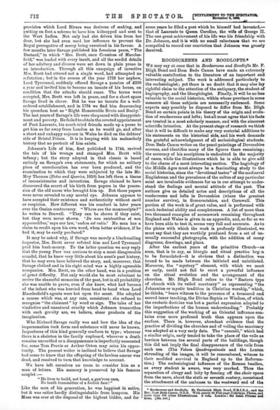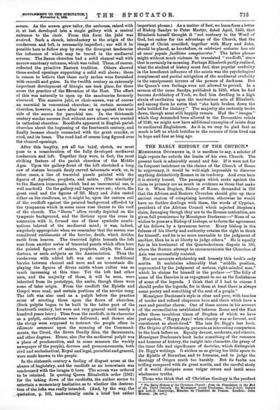ROODSCREENS AND ROODLOFTS.*
WE may say at once that in Roodscreens and Roodlofts Mr. F. Bligh Bond and Dom Bede Camm have made an extremely valuable contribution to the literature of an important and interesting subject. The work is addressed particularly to the ecclesiologist ; yet there is no doubt that it may also lay rightful claim to the attention of the antiquary, the student of hagiography, and the liturgiologist. Finally, it will be no less valuable to the social historian, within whose province in some measure all these subjects are necessarily embraced. Some experts may possibly be disposed to differ from Mr. Bligh Bond on certain points in his theory of the origin and evolu- tion of roodscreens and lofts; but all must agree that his facts are treated in a most scholarly manner, and with the sincerest scientific intention. At the present stage of research we think that it will be difficult to make any very material additions to his statements on the historical side, and his work demands the grateful acknowledgment of all ecclesiological students. Dom Bede Camm writes on the panel-paintings of Devonshire screens, and identifies many of the figures there remaining; the accuracy of his ascriptions is undoubted in the majority of cases, while the illustrations which he is able to give add to the charm of a most interesting section. The hagiology of the Middle Ages must always be a fascinating study to the social historian, since the "devotional tastes" of the mediaeval Englishman and the prevalence of the callus of any particular saint are invaluable evidences for us in our attempt to under- stand the feelings and mental attitude of the past. The authors give us detailed notes and descriptions of all the roodscreens and lofts in Devonshire (where the greatest number survive), in Somersetshire, and Cornwall. This portion of the work is of great value, and is performed with much technical ability and completeness. A list of more than two thousand examples of screenwork remaining throughout England and Wales is given in an appendix, and, so far as we have been able to test it, seems very full and accurate. As to the plates with which the work is profusely illustrated, we must say that they are worthily produced from a set of un- usually successful photographs, with the addition of many diagrams, drawings, and plans.
After the earliest years of the primitive Church—as soon, that is to say, as liturgic and ritual practice beg: n to be formulated—it is obvious that a distinction was • bound to be made between the initiated and uninitiated. Moreover, the "mystery" element, with which we meet so early, could not fail to exert a powerful influence on the ritual evolution and the arrangement of the churches. Mr. Bligh Bond refers to the "Eastern type of church with its veiled sanctuary" as representing "the Johannine or mystic tradition in Christian worship," which, he thinks, "bears witness to the presence of a treasured and sacred inner teaching, the Divine Sophia or Wisdom, of which the exoteric doctrine was but a partial expression adapted to the imperfections of the human understanding." Probably this suggestion of the working of an Oriental influence con- tains even more profound truth than appears upon the surface. There is, however, abundant evidence that the practice of dividing the churches and of veiling the sanctuary was adopted at a very early date. The " cancelli," which had a similar origin, early tended to take the place of the veils as barriers between the several parts of the buildings, though this did not imply the final disappearance of the veils from such use. (The Velum Quadragesimale and the Lenten shrouding of the images, it will be remembered, witness to their modified survival in England up to the Reforma- tion.) The ecclesiological influence of the Roman basilica, as every student is aware, was very marked. Thus the separation of clergy and laity by fencing off the choir space from the nave, about the sixth or seventh century, occasioned the attachment of the ambones to the westward end of the • Boodscrsess as& Roodlefts. By Frederick Bligh Bond, F.B.LB.A., and the Bey. DOIll Pede camm,O.S.B. With nearly 90 Pull-page Collotype Plates, and more than 300 other Illustrations. 2 tole. London Sir Isaac Pitman and Sons. L32s. net.]
Screen. As the screen grew taller, the ambones, raised with it, at last developed into a single gallery with ,a central entrance to the choir. From this form the jitbe was evolved. Such a sketch, introductory to the origin of the roodscreen and loft, is necessarily imperfect ; nor will it be possible here to follow step by step the divergent tendencies the influence of which may be traced in the mediaeval screens. The Saxon churches had a solid chancel wall with narrow sanctuary entrance, which was veiled. These, of course, reflected the primitive Eastern tradition. Others showed three-arched openings supporting a solid wall above ; there is reason to believe that these early arches were furnished with cancelli and gates. In the twelfth century an extremely important development of liturgic use took place, for there arose the practice of the Elevation of the Host. The effect of this was naturally to open up the sanctuaries formerly obscured. The massive ube, or choir-screen, was of course an essential in conventual churches ; in certain monastic churches, however, a nave altar was set up against the west aide of the screen for parochial use. In the thirteenth century similar screens (but without nave altars) were erected in cathedral churches. Roodlofts appeared in English parish churches about the beginning of the fourteenth century, and finally became closely connected with the great crucifix, or rood, and its beam. The rood had of course long figured over the chancel openings.
After this lengthy, yet all too brief, sketch, we must pass to a consideration of the fully developed mediaeval roodscreen and loft. Together they were, in fact, the most striking feature of the parish churches of the Middle Ages. Upon the gallery-front of the loft stretched a long row of statues beneath finely carved tabernacle work, or, in other cases, a line of traceried panels painted with the figures of Apostles, prophets, and saints. (The similarity to the Eastern iconostasis, which had an immemorial use, is well marked.) On the gallery-rail tapers were set ; above, the great rood and the figures of SS. Mary and John rested either on the roodbeam, or, it might be, upon the eastern rail of the roodloft against the painted background afforded by the tympanum which in some cases rose thence to the roof of the church. The "Doom" often vividly depicted on the tympanic background, and the Saviour upon the cross in connexion with it, formed one of those symbolic combi- nations beloved of the mediaeval mind; it was, indeed, singularly appropriate when we remember that the screen was considered emblematic of the barrier, death, which divides earth from heaven. The traceried lights beneath the loft rose from another series of traceried panels which often bore the painted figures of saints, prophets, sibyls, the Latin doctors, or such subjects as the Annunciation. Thus the roodscreen with added loft was at once a traditional barrier between chancel and nave and an iconostasis dis- playing the figures of divers saints whose cultus was so much increasing at this time. Yet the loft had other uses, and the majority of these, it will be seen, were inherited from its prototype, the ambo, though there were some of later origin. From the roodloft the Epistle and Gospel were read, and certain portions of the service sung. The loft was also used as a pulpit before the practice arose of erecting these upon the floors of churches. (Such pulpits began to be built in the latter part of the fourteenth century, but were not very general until nearly a hundred years later.) Thus from the roodloft, in its character as a pulpit, exhortations were delivered ; and thence also the clergy were supposed to instruct the people often in idiomate communi upon the meaning of the Command- ments, the Creed, the Seven Deadly Sins, the Sacraments, and other dogmas. Hence, also (for the mediaeval pulpit was a place of proclamation, and in some measure the weekly newspaper of the people), decrees and pronouncements, both civil and ecclesiastical, Royal and legal, parochial and general, were made known to the people.
In the sixteenth century a feeling of disgust arose at the abuses of hagiolatry, and the roodloft as an iconostasis was condemned with the images it bore. The screen was ordered to be retained- In quoting Queen Elizabeth's order (1561) for the taking down. of the roodlofts, the author seems to entertain a momentary hesitation as to whether the destrue- • tion of the lofts was really intended. (And, by the way, the
• - quotation. p. 105, inadvertently omits a brief but rather important phrase.) As a matter of fact, we learn from a letter of Bishop Sandys to Peter Martyr, dated April, 1560, that Elizabeth herself thought it "not contrary to the Word of God, but rather for the advantage of the Church, that the image of Christ crucified, together with Mary and John, should be placed, as heretofore, in celebriori ecclesiae loco ubi ab ornni populo facillime conspiceretar." The latter phrase might without much violence be translated "roodloft," since that is certainly its meaning. Perhaps Elizabeth partly realised, what the student of history must feel, that popular credulity in the beneficent influence of the saints was the psychological complement and partial mitigation of the mediaeval credulity in the omnipresent terrors of the powers of darkness. But the Queen's own feelings were not allowed to prevail. In a sermon of the same Sandys, published in 1585, when he bad become Archbishop of York, we find him dwelling in a high strain of exultation upon the meritorious acts of Elizabeth, and among them he notes that "she bath broken down the lofts builded for idolatry." The majority she certainly broke down, though some still happily remain. Had the " images " which they demanded been allowed to the Devonshire rebels of 1549, we might now have additional examples of saints dear to mediaeval Englishmen. As it is, we may be glad that so much is left us which testifies to the courses of lives lived out in hope and fear so long ago.































































 Previous page
Previous page